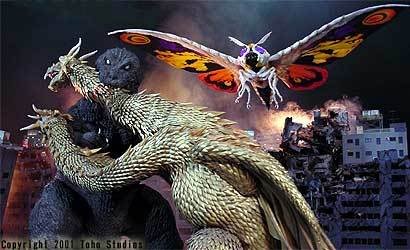Godzilla, Mothra and King Ghidorah: Giant Monsters All-Out Attack (2001)
Synopsis of Godzilla, Mothra and King Ghidorah: Giant Monsters All-Out Attack
Godzilla has returned, for the first time since 1954. Admiral Taizô Tachibana remembers first-hand his first attack, and tries to prepare the Japan Self-Defense Force for his return. Meanwhile, his daughter tries to capture the monster’s rampage on video as a reporter. However, Godzilla is more vicious than ever. Only the legendary Guardian Monsters (Mothra, Baragon and King Ghidora) stand between him and the destruction of Japan … They, and a few brave human beings.
movie review of Godzilla, Mothra and King Ghidorah: Giant Monsters All-Out Attack
In addition to the three guardian monsters, there’s a small cast of humans fighting as well. Primarily it’s Admiral Tachinaba, who lost his parents during the original 1954 attack by Godzilla. He is one of the few in the military who has been on the lookout for Godzilla’s return. Another central character is his daughter, Yuri, who works for a small cable channel, “the bargain basement”. She typically makes schlocky X-files style “documentaries”. Here she is actually critical to the discovery of the “guardian monsters.” She risks her life to covering the story. In the process, she brings some reconciliation to her relationship with her father as well.
In all, I have to admit that I enjoyed Godzilla, Mothra and King Ghidorah: Giant Monsters All-Out Attack. I recommend it for fans of the Godzilla movies. I rate it 3 stars out of 5.
Editorial review of Godzilla, Mothra and King Ghidorah: Giant Monsters All-Out Attack, courtesy of Amazon.com
This 2001 Godzilla feature from Japan’s Toho Studios, released as part of the mighty monster’s 50th anniversary, is a visually impressive and action-packed entry in the long-running franchise, but also one with a fast and loose re-interpretation of its history that may displease some stalwart fans. Writer-director Shusuke Kaneko (who previously revitalized the Gamera series) erases everything that occurred after 1954’s Godzilla and re-imagines the beast as a mythical creature harboring the souls of the Japanese victims of World War II; its attack is challenged by three “Guardian Monsters”: Mothra, perennial villain King Ghidorah (here reinvented as hero) and B-list player Baragon (from Frankenstein Challenges the World).
The retooling, while imaginative, is supported by spectacular special effects, but the monsters’ brawls (a core reason for enjoying these films) seem abbreviated, and Kaneko’s script experiences awkward seismic shifts from comedy to grim drama that may befuddle longtime G-fans. Columbia-Tri-Star’s DVD is widescreen and offers Dolby Digital 5.1 sound and a Japanese language track (with English subtitles) that should please viewers with an aversion to dubbing. Trailers for other Sony/Columbia sci-fi titles like the American Godzilla feature are also included. —Paul Gaita
Movie quotes from Godzilla, Mothra and King Ghidorah: Giant Monsters All-Out Attack
[Yuri tries to convince her boss on doing a story about the possible return of Godzilla]
Yuri: You don’t sound interested.
Kadokura: …Godzilla is passe.
[recalling his encounter as a child with Godzilla in 1954]
Adm. Tachinaba: The sky was blood red and filled with smoke. And through it a devil appeared, its face was twisted with rage and hatred. When it was over my parents were gone. I will never forget the wretched cries of the dead …
Store Manager: [into bullhorn]: Attention, Godzilla is approaching. Everyone evacuate this store at once.
Woman Shopper: Godzilla — who cares.
[Baragon is approaching in the distance]
Husband: It’s the red Godzilla.
Wife: He may be frightening, but he’s cute.
Husband: Quick, take a picture before we run.
Yuri: The 1000 Year Dragon”… King Ghidorah.
Yuri: Father … don’t give up.
[Yuri is saluting her father who has just defeated Godzilla]
Adm. Tachinaba: Yuri — stop it. You’re embarrassing me. Don’t salute me; instead salute my comrades … and the guardian monsters.
Trivia for Godzilla, Mothra and King Ghidorah: Giant Monsters All-Out Attack
- Godzilla, Mothra and King Ghidorah: Giant Monsters All-Out Attack is the first film where King Ghidorah is a “hero” character; also the first film where King Ghidorah is actually smaller than Godzilla.
- Cameo: [Mizuho Yoshida] The pink-shirted young man (wearing a black baseball cap) standing behind the twin teenage girls in Yokohama when Mothra flies over the area. Yoshida is also the stuntman playing Godzilla.
- This was the first film since Mothra vs. Godzilla (1964) to portray Godzilla as truly evil. Director Shusuke Kaneko preferred the original “evil” Godzilla for his film, and comes up with an unusual motivation (Godzilla, a monster brought to life by nuclear weapons, is a “specter of war”).
- In the opening scene, Admiral Tachibana lectures his troops on the incident from Godzilla (1954), and notes that “a monster similar to Godzilla ravaged New York at the end of the last century.” This was a reference (and jab) to Godzilla (1998), the oft-disparaged Hollywood remake. Audiences in Japan both laughed and cheered at this scene.
- As a departure from the established Mothra mythos, the diminutive and singing Shobijin Twins are absent. In fact, the twins Ai Maeda and Aki Maeda make a small cameo as two identically-dressed twins. They are seen during the scene where Mothra flies over Yokohama. Their roles are not related to Mothra in the movie, but that bit is a clear nod to the classic Shobijin.
- Cameo: [Takehiro Murata] Jet fighter pilot. Murata has had roles in numerous Godzilla films, including the lead role in Godzilla 2000 (1999).
